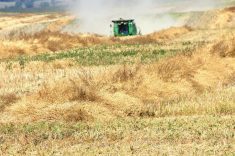SASKATOON – Wilf Jurke expects to have plenty of visitors at his elk ranch this fall.
That’s when hunters, mostly Americans, will begin arriving with the hope of tagging themselves a big bull elk.
Close to 65 people have already booked a spot on the hunting roster at Jurke’s ranch near Lloydminster, Sask. Those people are willing to pay an average of $10,000 (U.S.) for the experience of hunting a bull elk in Canada.
“The interest has been phenomenal,” said Jurke. “It’s very popular.”
Read Also

Alberta researcher helps unlock the economics of farming
Lethbridge Polytechnic researcher helping agriculture producers with decision-making tools in economic feasibility
New regulations are being developed to govern the hunting of elk and deer on Saskatchewan game farms. Those rules, which are being drafted by the provincial agriculture department, might be completed as early as September.
About 75 farm elk are expected to be legally shot by hunters in Saskatchewan this year. The Saskatchewan Elk Breeders Association hopes the province’s new regulations will recognize the importance of allowing hunting on game farms.
“It’ll be a vital part of our industry,” said Terri Harris, the association’s executive director.
“It’ll guarantee elk producers a market for their older bulls.”
Hunting of farm elk is already allowed in Saskatchewan through what Harris describes as a loophole in provincial rules governing game farms. Elk farmers require a licence before they can kill any of their elk for meat processing. Although there are restrictions, a farmer may allow hunters to shoot elk under that licence.
“It’s legal to do that, but it’s cumbersome for everyone involved,” said Al Choquer, of Saskatchewan Agriculture.
The new regulations should streamline the process needed to allow hunting on elk farms, Choquer said. However, he added the rules will also take the concerns of wildlife interests into account.
“What we’re looking at are guidelines that are acceptable to the industry, the public and government.”
It’s a juggling act, he said, because of the strong opinions held by people on both sides of the issue.
There are about 350 elk farms in Saskatchewan raising close to 16,500 mature animals.
Breeding stock normally commands premium prices, as do the elks’ antlers, which are coveted in certain cultures due to perceived health benefits.
Allowing hunters onto elk farms is another way to diversify the rapidly evolving enterprise. Harris remains confident hunting will be done in a moderate and well-controlled manner once the new rules are in place this fall.
“It’s not going to be a free-for-all,” she said. “The producers wouldn’t want that either because it would hurt our image. We know there are concerns out there.”
Among those voicing opposition to hunting farm elk is Stan Struthers, NDP natural resources critic in Manitoba. Allowing hunters to stalk elk in captivity is viewed by Struthers as a “vile practice.”
The subject was raised in the Manitoba Legislature earlier this year, when it was reported that an interdepartmental committee was reviewing the pros and cons of penned hunting.
At the time, natural resources minister Glen Cummings said such a practice violates good sportsmanship.
Since then, the idea of allowing people to hunt penned elk has been rejected in Manitoba.
The topic won’t be up for review in the “foreseeable future,” said John Taylor, director of Manitoba Agriculture’s animal industry branch.
“There will be no hunt farms in Manitoba,” Taylor said last week. “That’s not a change for us. It was already in legislation in Manitoba.”
Hunt farms are popular in Africa, Europe and parts of the United States. People such as Jurke are now banking on that popularity and the money that it can attract to Saskatchewan.
Jurke knows there are people who oppose the idea of hunting farm elk.
However, he said there’s more sportsmanship involved than people may realize.
Jurke said he allows only one hunter onto his pastures at a time. Each bull elk is released onto no less than two sections of land, he said.
“Being that they’re raised by man, they’re very intelligent to men. They do not get as excited or flush as easily as a wild one would and they hide far better than a wild elk or deer would.”
Saskatchewan elk farmers also have the option of shipping their bulls to American buyers wanting to use them for hunting quarry. However, Jurke said it’s a slow, costly process getting the animal across the border.
“The transportation costs were absolutely ridiculous. It’s much easier to transport the hunter.”














